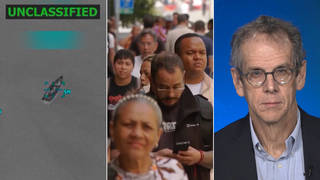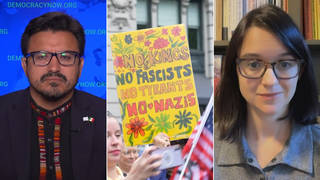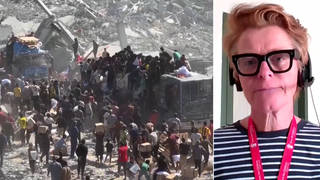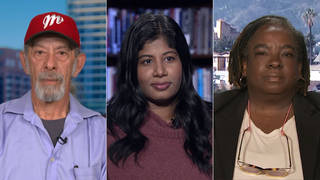
Guests
- Randi Weingartenpresident of the American Federation of Teachers.
- Stacy Davis Gatesexecutive vice president of the Chicago Teachers Union.
As school districts across the U.S. debate how to safely bring children into the classroom, we speak with two leaders of the teachers’ union movement on what’s at stake as schools reopen. Stacy Davis Gates, executive vice president of the Chicago Teachers Union, says years of underfunding and privatization have left many school districts ill-equipped to meet the needs of students, as well as educators. “It’s not just the context of opening schools. It’s reopening schools safely with the resources that are necessary to keep people safe,” she tells Democracy Now! We also speak with Randi Weingarten, president of the American Federation of Teachers, who says when a clear safety program is in place, a majority of teachers are on board with returning to in-class instruction. “The people who are in school trust it and trust that they’re going to be safe,” Weingarten says.
Transcript
AMY GOODMAN: We begin today’s show looking at the state of the nation’s school a year into the COVID-19 pandemic. On Tuesday night, President Biden said teachers should be given higher priority to get vaccines, and he pledged to reopen the majority of elementary schools in his first 100 days. Biden made the comments at a town hall meeting in Milwaukee hosted by CNN’s Anderson Cooper.
PRESIDENT JOE BIDEN: I think that we should be vaccinating teachers. We should move them up in the hierarchy, as well.
ANDERSON COOPER: Well, let me ask you. Your administration had set a goal to open the majority of schools in your first hundred days. You’re now saying that means those schools may only be open for at least one day a week.
PRESIDENT JOE BIDEN: No, that’s not true. That’s what was reported. That’s not true, and it was a mistake in the communication. But what I’ve — what I’m talking about is I said opening the majority of schools in K through eighth grade, because they’re the easiest to open, the most needed to be open in terms of the impact on children and families having to stay home.
ANDERSON COOPER: So, when do you think that would be K through eight at least five days a week, if possible?
PRESIDENT JOE BIDEN: I think we’ll be — I think we’ll be close to that at the end of the first hundred days. We’d have a significant percentage of them being able to be opened. My guess is they’re going to probably be pushing to open all for all summer, to continue like it’s a different semester. [inaudible]
ANDERSON COOPER: Do you think that would be five days a week or just a couple?
PRESIDENT JOE BIDEN: I think — I think, many of them, five days a week. The goal will be five days a week. Now, it’s going to be harder to open up the high schools, for the reasons I said.
AMY GOODMAN: President Biden, speaking Tuesday night. This comes as many school districts across the nation are debating how to safely bring children back into the classroom. In Chicago, the city has begun reopening schools for the district’s youngest students, following a fight between the city and the teachers’ union over COVID protocols. Meanwhile, the Centers for Disease Control and Prevention has faced criticism for saying schools can be reopened safely before teachers are vaccinated. This is CDC Director Dr. Rochelle Walensky speaking earlier this month.
DR. ROCHELLE WALENSKY: I would also say that safe reopening of schools is not — that vaccination of teachers is not a prerequisite for safe reopening of schools.
AMY GOODMAN: We’re joined now by two guests. Randi Weingarten is president of the American Federation of Teachers, and Stacy Davis Gates is executive vice president of the Chicago Teachers Union.
We welcome you both to Democracy Now! Let’s begin here in New York. Randi Weingarten, talk about the state of the schools in New York City and what the American Federation of Teachers is demanding.
RANDI WEINGARTEN: So, you know, what we’re demanding in New York and what we demanded in Chicago — and I’m so glad that you have Stacy on — is quite similar. There’s a protocol of about five things, including prioritizing teachers for vaccines; using testing, like the NFL does, like industry does, as a way of really seeing what’s unseen; and then the kind of the safety protocols that were in the CDC guidance, including — and Chicago and New York have done a good job about this because the union has pushed it so hard — including making sure that those who are at risk or who are taking care of people at risk have reasonable accommodations.
And so, when you have these kind of protocols together and you have safety committees and ways in which you make sure that these are enforced, what we just saw, in a recent poll we released last night, is that the people who are in school trust it and trust that they’re going to be safe. And so, 88% of my membership in this poll that we just did last week said if we could get these protocols, they will feel comfortable being in school. They know it’s important. And that includes 73% of those who are on remote right now.
AMY GOODMAN: So, what’s happening in New York right now? Who is back in school? Who is doing remote learning? And what do you see as the timetable?
RANDI WEINGARTEN: So, what’s happening in New York right now is that elementary schools — so, parents have a choice in all of these districts whether or not they have their kids in person or on remote. In New York City, they started — they reopened everything in a hybrid basis, in a blended basis, in September, October and November. In November, when the rates started going very high in New York, there was a three-week pause, and then they reopened in December, elementary schools and special ed and kids with special needs first, so pre-K, elementary and kids with special needs. And those kids are back in schools most of the week. This Monday and Tuesday, they will start reopening in New York City middle schools.
And what they have in New York City, which is the key to this reopening, is a very fulsome testing program, so that 20 to 25% of people every week — kids and teachers — get tested, to rapid antigen and PCR tests, to see if there is COVID transmission in school. And there’s real protocols about, if there’s a case, that classroom gets closed. If there’s two or three non-vectored cases, meaning cases — after you contact trace, cases coming from different ways, the school will get closed for 10 days or so. And that has been what has kept the schools open and transmission down. So, it is both the protocols that CDC talked about that prevent transmission, but also the testing so that you see it.
And finally — and this is what Stacy pushed for really hard in Chicago and what Michael Mulgrew, our leader in New York, pushed for really hard in New York — is the vaccinations. And over 15,000 New York City schoolteachers, people who are in schools first, have gotten their first — some have gotten their second — dose of the vaccination. And I’m really glad that President Biden said last night that teachers should be prioritized. We’ve tried to do that for the last several months. We pushed very hard for the CDC to prioritize teachers. If schools were supposed to be open for in-person learning, because that’s important, then we need that extra layer of protection for teachers, just like, obviously, for healthcare workers and for nursing homes. But it has not happened in most places. Twenty-four states do prioritize teachers, but we have not seen that in action as much as we should.
AMY GOODMAN: So, Stacy Gates, the NEA, the National Education Association, just did a survey. They said 82% of teachers have not been vaccinated, 70% will feel safer about working in person once vaccinated, 20% of white educators are vaccinated, 9% of Black educators are vaccinated. Can you talk about the significance of this?
STACY DAVIS GATES: I think the significance of this entire pandemic has fallen along the lines of race, racism, equity and inequity. And what we see here is the collapse of a society at the same time we need the most — we need the most.
For instance, we’re having a discussion about reopening schools without understanding what types of schools we’re reopening. There is a standard that I think most people are thinking of when they think of schools. They’re not thinking of schools on the West Side of Chicago whose facilities haven’t been upgraded for a generation. They’re not thinking of schools on the South Side of Chicago that have been perpetually unclean because we have privatized our janitorial staff.
These are things that should be added to the context of CDC guidelines. CDC guidelines are only as important as they can be implemented in places that have the resources to implement it, places that have administrative fortitude and a workforce that are willing to enforce it. Guidelines are one thing. The implementation and then the enforcement are quite another.
And in Chicago, we have a hard time believing that, under mayoral control, that we would have the type of enforcement of these guidelines all by itself, because we haven’t seen that indeed. Again, it won’t be until the end of our contract until we have a nurse in every school. There’s not a social worker in every school. So, when I hear people talk about kids need to be in school because of all of the things that our schools provide, well, you need to come to Chicago and see what our schools have and don’t have, and struggle with the educators, the paraprofessionals, the school clerks, the clinicians, the tech coordinators that are trying to make that happen here in Chicago. We fought for a nurse in every school. We have fought for air conditioning in school. We only have four schools on the West Side of Chicago that have school libraries. It’s not just the context of opening schools. It’s reopening schools safely with the resources that are necessary to keep people safe.
AMY GOODMAN: So, Stacy, the Chicago Teachers Union and the Chicago Public Schools have reached an agreement last week to reopen elementary and middle schools amidst the pandemic. By early March, students who have been learning remotely for 10 months will be back in the classrooms. What is key to understand about this agreement and the tense negotiations that took place between the union, the school district and Mayor Lightfoot? And where did parents and teachers, parents and students, come down in this negotiation?
STACY DAVIS GATES: Well, one of the things that I would like to dispel is that there is a separation of parents and teachers. I myself am a high school history teacher with three children in the Chicago Public Schools, as do many of our — as are many of our colleagues in the Chicago Public Schools. So, to erect this false narrative that parents and teachers are on opposite sides, when we are actually the same person, is absolutely ridiculous. That’s one.
Number two, this was a discussion about the inequities of the pandemic. If we are looking at Chicago right now, and we’re looking at the communities in the ZIP codes — because Chicago is still so very segregated — that were ravaged under COVID-19, and we look at the distribution of vaccines in Chicago in the same communities, we see an inequity. When we look at the Chicago Public Schools and how our schools are funded in the city, we see that same inequity.
So, the struggle to get the agreement is based on generations of neglect and defunding and deprioritization. Again, why would I trust you to have my back in a pandemic when I was unable to trust you to have my back in nonpandemic times? This boils down to a legacy of distrust, because we’ve been deprioritized. Again, Chicago Public Schools, under mayoral control, closed 50 schools that educated Black children. Again, in a pandemic that is killing Black people three times more than white people, why would you have infrastructure of trust there?
You have to rebuild the trust and the confidence of the individuals who will be attending these school communities, going inside of these buildings, as well as showing where the resources have been implemented and also maintaining the implementation of those resources. We’re in a pandemic. I don’t think it’s a big — I don’t think it’s unreasonable for people to have an expectation that you pull together in the same direction and that you have front safety as the uniting factor.
AMY GOODMAN: I want to read a quote from Chicago Mayor Lori Lightfoot, who was recently interviewed by The New York Times. She said, quote, “I understand that the notion that we would lock teachers out was disturbing to all. It should be. But it should also be disturbing when teachers say: 'I don't care what you say. I don’t care what you do. I’m not going to abide by the contract or the rules that have been set for my place of employment,’” Lightfoot said. “That’s chaos.” Stacy Davis Gates, if you could respond?
STACY DAVIS GATES: I don’t think there is a response to that. For the life of me, I do not know why any politician would harbor ill will and provoke fights with teachers, with paraprofessionals and school clerks, tech coordinators and social workers, counselors, librarians. I don’t understand that.
Furthermore, the members of the Chicago Teachers Union, in coalition with parents and students across the city, have struggled together. They’ve struggled together to get an elected school board. They’ve struggled together to get cops out of schools. They’ve struggled together to get nurses and social workers inside of schools, to bring the issue of housing and security to the forefront and fight for housing for our students who do not have permanent housing. So this concept that we’re not partners is simply another misleading action, statement from the mayor of the city.
AMY GOODMAN: And if you can talk about the importance of organizing and striking, right now in this period during the pandemic, the most effective way you see to keep the schools safe and to bring everyone back together?
STACY DAVIS GATES: Well, the most effective way is going to have to be with democracy. So, number one, Chicago has needed an elected school board for a very long time. Our mayor ran under that. She has so far yet to deliver. Democracy provides a very important set of checks and balances where stakeholders across the board have a way under which to interact. That’s number one.
Number two, you have to have a labor union that is committed to the common good struggle, in that we, as educators, provide a common good, therefore we should be at the fore pushing for all of the things that our entity needs, as well as the people that we serve. There’s no separation. Humanity basically forces us to provide the type of housing stability, the fight for justice in healthcare, the fight for the full resourcing of our school communities, but our neighborhood communities, as well.
Look, Chicago has undergone a seismic shift since 2012, when our union, with parents, with grassroots organizations and with students, said that Chicago students deserve more than what they have been given. And right now we are continuing to manifest that type of organization, that fight, that advocacy, where all people who are in the city get to win, not just the select few, not just the few who can buy it, but the many who need it.
AMY GOODMAN: And before you go, Stacy, I wanted to ask you about Karen Lewis, the former president of the Chicago Teachers Union who recently passed away at 67 years old. She had been battling brain cancer. She stepped down from her position at CTU due to her health four years later. This is Karen Lewis on Democracy Now! in 2010.
KAREN LEWIS: I don’t think anybody will argue with that, that the system is broken. It is — it has not basically changed since the 1900s — 1800s, for that matter. And as a result, it has never been able to absorb real innovation. And the problem is, it’s just a lot easier to test, test, test children. Our curriculum has narrowed in Chicago. If you look at the average day for an elementary school kid, it’s reading, reading, reading, reading, reading, math, math, math, reading, reading, reading, reading, math. I mean, kids are bored to tears. They’re hating school at an early age. There’s no joy. There’s no passion. And the results show that.
AMY GOODMAN: So, that’s Karen Lewis in 2010. Your thoughts on her passing and her significance as former head of the Chicago Teachers Union?
STACY DAVIS GATES: Obviously, with her passing, I not only miss a great leader, I miss a friend, someone who cared for me and very generously gave me an opportunity to work in this movement and to be powerful in this movement.
And number two, I think her significance is that she has shifted the trajectory of the expectations of everyone in the city of Chicago. Nationally, she has triggered red from the West Coast to the East Coast to the Northern part to the Southern part of our country. And as a Black woman, she walked in her power, she walked in truth, and she defended Black children. She lifted up Black parents. And she gave us an example of how you lead in coalition, how you distribute power and provide a bellwether, if you will, for leaders who are committed to social justice.
AMY GOODMAN: Well, I want to thank you so much, Stacy Davis Gates, executive vice president of the Chicago Teachers Union, and Randi Weingarten, president of the American Federation of Teachers.
Next up, we go to Bessemer, Alabama, where Amazon workers are voting on whether to become the first unionized Amazon warehouse in the country. Stay with us.
[break]
AMY GOODMAN: That’s the Spanish rapper Pablo Hasél, who was arrested in the Catalan city of Lleida on Tuesday for insulting Spain’s former king and for showing support for the Basque separatist group ETA. His arrest sparked massive protests in Barcelona and other cities.












Media Options